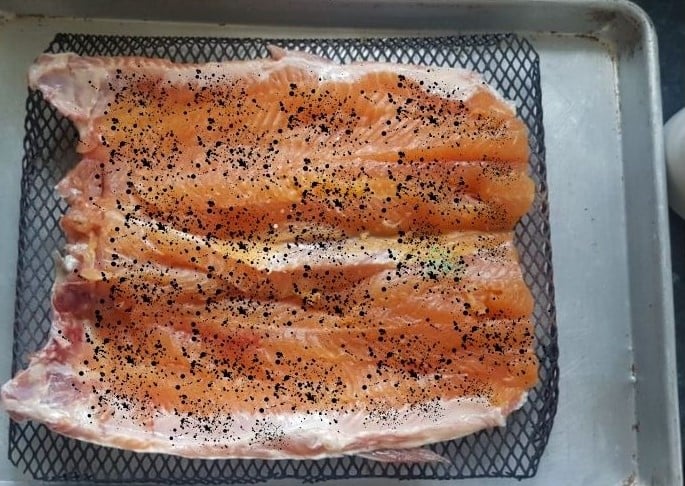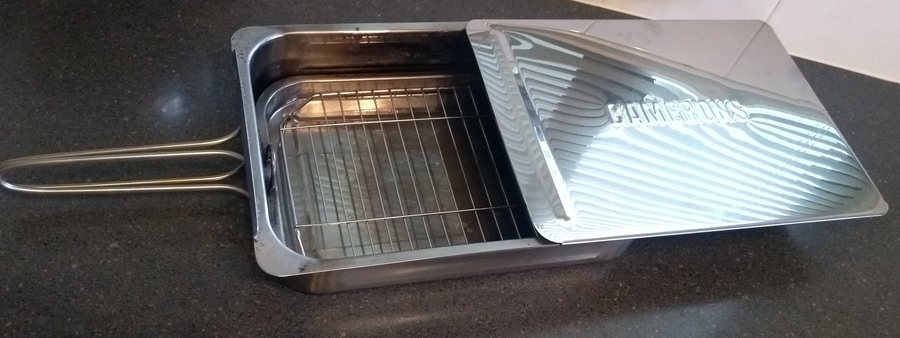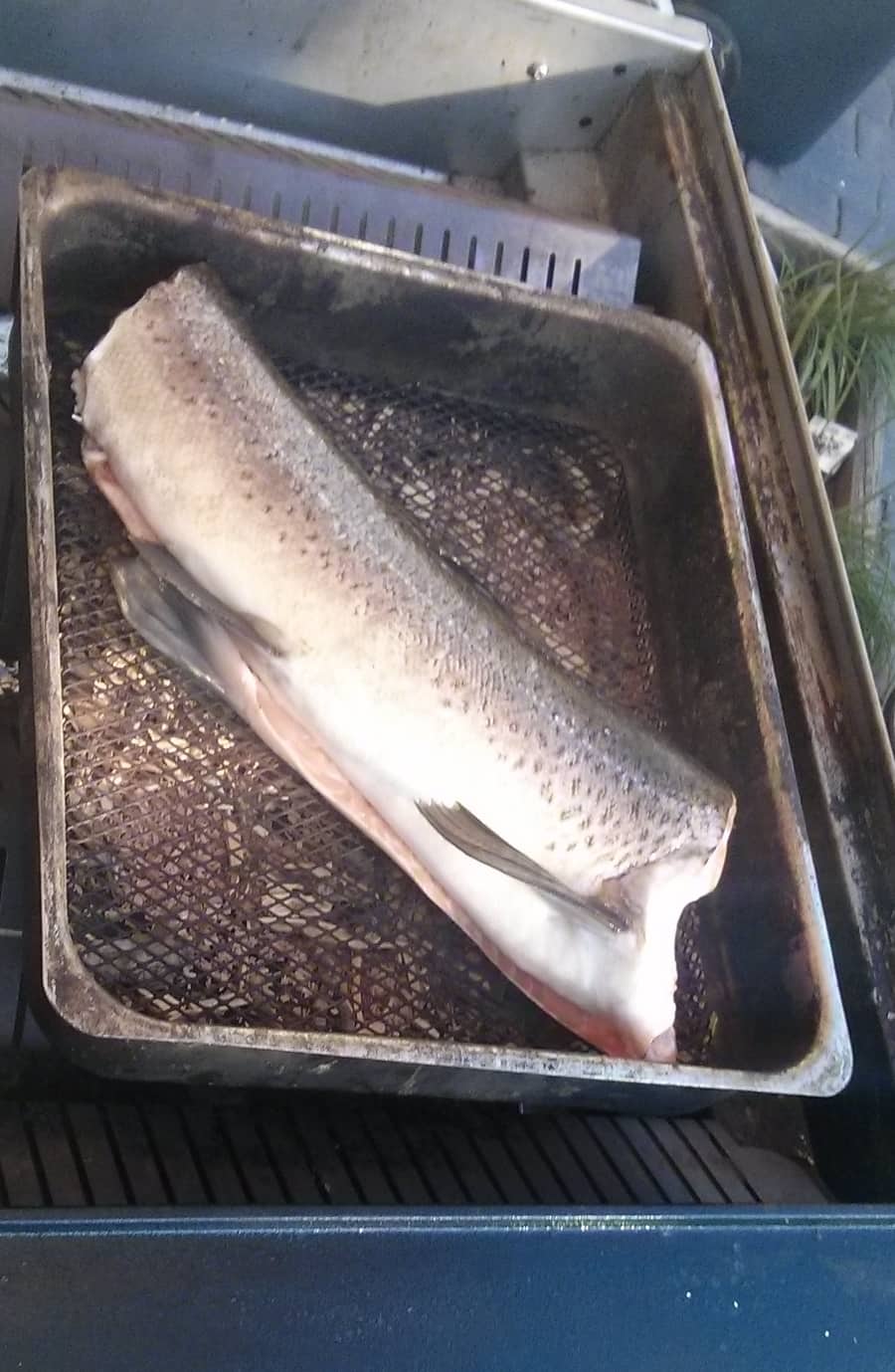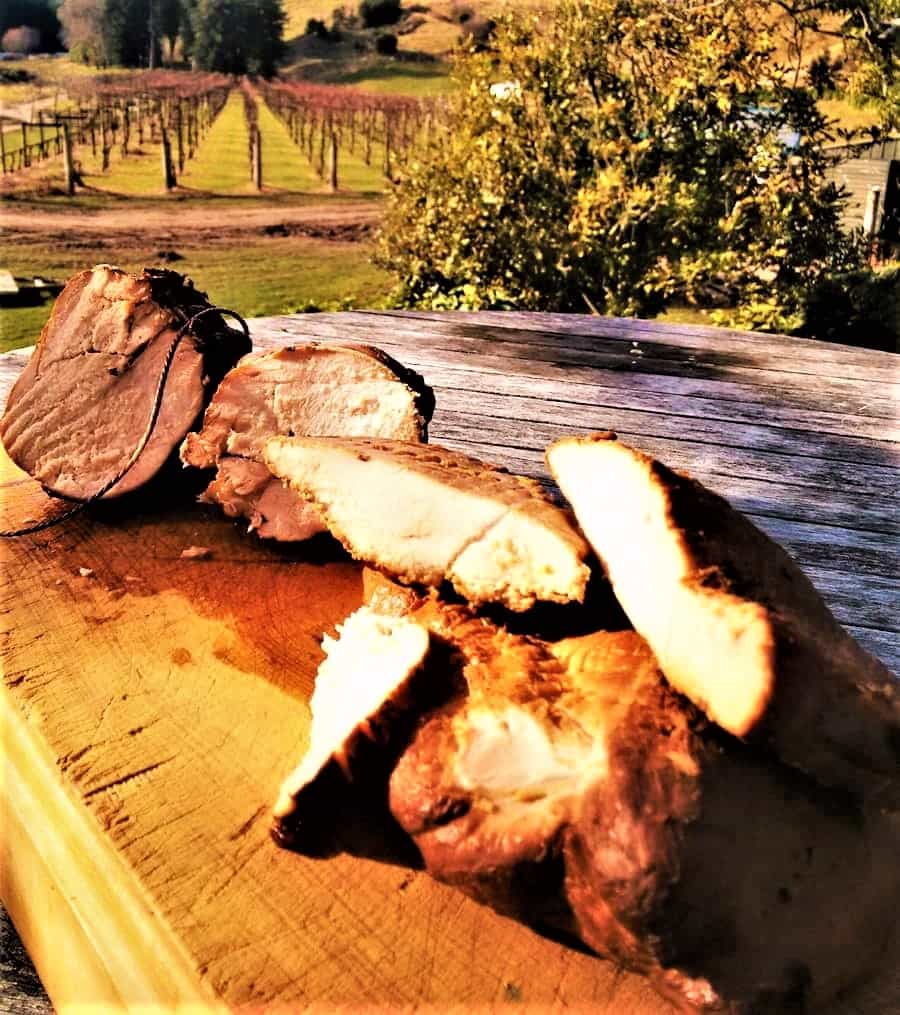Over the years, I’ve smoked hundreds of trout, & used a portable smoker in quite a few different ways.
I wanted to share my ‘simplest’ way and easiest style of hot-smoking trout on a portable, simple smoker.
Simple Way to Smoke Trout in A Portable Smoker
- Sprinkle Salt and Brown Sugar on Trout
- Leave for 6-12 hours in Fridge
- Place in Portable Smoker
- Place Wood in the Smoker, Turn the Heat to Medium
- Smoke for 10-12 minutes
I couldn’t find it online, so I thought I would post this easy-to-follow guide, which I use at home or when I’m camping and fishing in the wild. I’ve been using this technique for 20 years.
As opposed to indirect Low and Slow style smoking, this method is quicker and easier.
This is one way of smoking trout that won’t take an hour or two to cook/smoke. Most times I do this with trout (here are other ideas I wrote about for cooking on a campfire), it take less then 15 minutes to cook/smoke.

Smoking Trout with a Portable Smoker

Steps for Hot Smoking Trout on a Portable Smoker
1. Sprinkle Salt and Brown Sugar on Trout
It depends on the trout is thickness and whether you are smoking it whole or just the fillet.
It’s a pretty light sprinkling, transparent or ‘see-through’, not a lot of salt and sugar, a little bit more around the thicker areas a little less towards the tail.
I use about half the sugar to the amount of salt on the trout.

The salt will help dry out the outside(which smoke can adhere to better) and retain moisture inside.
Also, the salt helps form the pellicle, so you know the smoke vapor will stick to the meat more.
If you’re using trout fillets, you want to have the skin side facing down and the meat exposed. I only sprinkle the trout fillets with salt and sugar on the meat side.
(The skin will probably stick to the rack underneath, but it also protects the meat)
Another helpful tip is to check if the skin remains after you have scraped it off. Just use a gas/propane burner on the grill to burn off any leftover skin.
2. Leave for 6-12 Hours in Fridge
Uncovered – place the trout in the fridge, if you can figure out a way of setting the whole trout on its spine or putting it on a rack gives it a bit more airflow which helps develop the pellicle.
The pellicle is like the binding of surface proteins; it gets a little bit sticky when you touch it (the meat is protecting itself, but this is the way to get smoke flavor/vapor sticking to the meat).
3. Place in Portable Smoker
It’s a straightforward device this type of ‘direct heat’ portable smoker, I have found that a two-piece smoker that doesn’t have rivets can be a bit better.
One piece is a molded ‘pan’ shape, and another slides the lid on.
A few on the market are flat packed, and then you just join the unit together. When I have been using denatured alcohol / Methylated Spirits as a heat source, the flavor has sometimes been a bit off.
Denatured alcohol burners come with some portable smokers; I’ve had mixed results with these and prefer a gas burner element inside.
This is the kind of smoke I don’t like to use!
But gives you an idea.
- Don’t like the smoker’s super lightweight design
- Denatured alcohol burner, not for me
- It looks over-smoked to me!
- Get the basics right, but I use all sorts of wood – pellets, sawdust, grapevine trimmings.
I usually use a gas burner or the side down on my gas grill BBQ at home.
Turned down to low, I leave the lid off and wait till the wood starts to smoke, put it in the grill the fish sits on, and then put it in.
I close up the lid for most light and medium types of wood like apple or beech.
But for heavier woods or mixing of hickory or oak, I might leave half an inch of the lid open for a little bit of airflow.
Less smoke flavor is better than too much, when you get too much smoke flavor and a direct smoke it can lead to bitterness.
So you want one like this, I reckon.


To produce this!

They are fantastic for taking in the back of the car if you’re camping or fishing.
My brother prefers to smoke the trout with no salt or sugar cure. You are a wood-fired oven cooking with a bit of smoke. This leads to more “trouty” flavorlessness. You want good trout from clean waters for this!
I have sometimes got a little bit technical. Still, it’s unnecessary, and we used the temperature probe to get an idea of the temperature inside the small portable smoke chamber, holding it around 270°F/130°C, which is the high end of “low & slow” smoking.
You can use portable smokers directly on a campfire, waiting until some fire has turned to embers and placing the smoker on this. You don’t have so much control; it takes a bit of learning this way. But it can be suitable for car/truck camping adventures (Bring an old sheet to wrap the smoker up; it will be messy!)
One of the best things about these types of smokers is that you can use many different shapes and sizes of wood.
I often use dried-out prunings from the grapevine since the sticks haven’t been chipped. Half a handful is enough to smoke some trout.
4. Place Wood in the Smoker, Turn the Heat to Medium
It’s good to keep an eye on the heat you don’t want to be pumping out massive amounts of smoke, too much heat will equal too much smoke with results in bitter trout.
How much smoke you get from a few tablespoons of sawdust is fantastic!
The temperature drops significantly every time you open it up, so checking every 4-5 minutes is probably best.
5. Smoke for 10-12 minutes
You can poke the fish with a knife, and once it starts to flake a little bit – you can see that it’s ready. Flaking from the thickest part of the fish, it’s obvious when bits are still raw.
Apart from this, it has never taken me longer than 15 minutes to smoke trout (here are other trout smoking ways I wrote about) using a portable smoke!

Brining Trout Vs. Dry Curing Salt
Some recipes use a salt and sugar brine to hold the moisture in the trout.
Each one to their own, wet salt brines tend to dilute / dry curing tends to intensify. This simple style of curing is above seasoning, nearly curing to some extent.
Using a dry brine or wet brine – helps to create the pellicle before you start smoking.
I prefer a sprinkling of salt and sugar or simply dry curing.
Direct Smoker Vs. In-Direct Smoker
Both can produce decent results, but I love using portable smokers like these for smoking fresh sausages and turkey breasts. We were even having fun smoking corn (here is my smoked wild turkey with oak/pistachio shells!)

It’s a fast, portable oven with smoke. For the turkey, I stuck a probe in to make sure it was hitting the internal safe cooked temperature (for turkey, I do wet brine)
Which Portable Smoker to Use
I touched on this above, but here are a few other options.
Here is a robust option
Camerons Large Stove Top Smoker (large is a good size)
I wrote a bit more about other portable smokers here, too.
How to Get the Right Saltiness in the Trout
With meat curing, there is a modern method called equilibrium curing or brining. This is working out the percentage of salt to the weight of the meat.
I have a relatively popular calculator at the top of the page. It’s used for dry-curing meat, such as dry-cured bacon or braesola.
0.5% to 1% would be about the amount of salt if you were to measure it, but with equilibrium curing, you really need accurate digital scales to one decimal place or ideally to decimal places (scales like on this page)
If you want to read more about equilibrium curing meat, I wrote about it here.
If you want to cold-smoke a trout, I have a (long) post about the basics of cold smoking here.

Tom Mueller
For decades, immersed in studying, working, learning, and teaching the craft of meat curing, sharing the passion and showcasing the world of charcuterie and smoked meat. Read More
